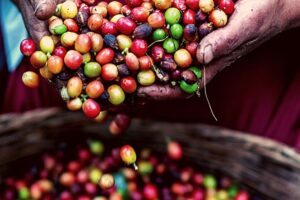Coffee beans are actually green seeds from a piece of fruit known as a coffee cherry and it measures around 6/10 inches (1.5 cm) long. The coffee bean begins as a light green, unripe berry that gradually ripens to yellow, after which it turns an orange/crimson color before turning dark reddish-black, at which time the fruit is ready to be harvested for the green coffee beans.
The ripening process of the coffee cherry takes on average about seven to eight months but is most determined by the color of the cherry. A more accurate method of determining optimum ripeness involves gently squeezing the fruit to see if the seed will easily fall out. This happens just before the fruit is completely red.
There are two basic versions of the coffee bean that we consume: either the Robusta or Arabica
- Arabica beans are grown on low (3-6 feet) shrubby plants that bear white blossoms that produce the coffee fruit called “cherries” (about the size and color of cranberries).
- Robusta beans is a shallow root system and grows as a robust tree about 10m tall. It flowers irregularly, taking about 10-11 months for berries to ripen, producing oval-shaped beans.
The process from the coffee cherry to the roasted coffee bean is as follows:
Step: 1 – THE PICKING
About 85 beans are used in one cup of coffee and seeing as there are only 2 beans in each cherry, that means 170 coffee cherries had to be hand-picked from a tree while it was approximately 1 billion degrees in a place like Ethiopia.
coffee cherries had to be hand-picked from a tree while it was approximately 1 billion degrees in a place like Ethiopia.
STEP 2: DRYING AND SEPARATION
Coffee grows in very different parts of the world. It grows at super high elevations in Ethiopia. It grows in the extra sticky air of Indonesia aswell as in the volcanic soil of Honduras. So, it totally makes sense that each region is going to have different resources at their disposal.
By exposing coffee beans to water, or not exposing them to water, fermenting them, or not fermenting them-all those things do have an effect on the flavor. That is why you see processing method terminology pop up on your coffee bag.
STEP 3: SORTING THE GREEN COFFEE BEANS
This process is meant to remove the defect beans and any small rocks and bugs that get mixed in. It’s done both by hand and by machine
STEP 4: EXPORTING THE GREEN COFFEE BEANS
The green coffee beans are placed in big burlap sacks and shipped to importers in the USA.
STEP 5: ROASTING THE GREEN COFFEE BEANS
This is when a burlap sack of green coffee is finally shipped to a roaster, like One Village Coffee, for roasting. We roast it and then it looks like the coffee you grind up at home
And there you have it, the process from the coffee being a fruit to the strong scented, dried coffee bean that grind at your home.
